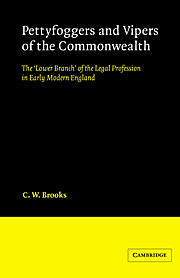 Pettyfoggers and Vipers of the Commonwealth
Pettyfoggers and Vipers of the Commonwealth Book contents
- Frontmatter
- Contents
- List of tables and figures
- Preface
- Abbreviations
- 1 Introduction
- 2 Lawyers and the royal courts in London during the reign of Elizabeth
- 3 The legal profession in the provinces
- 4 The increase in litigation
- 5 The causes of the increase in litigation
- 6 The increase in litigation and the legal profession
- 7 The attitudes of layman and attempts at reform
- 8 Clerkship, the inns of chancery, and legal education
- 9 Private practice
- 10 Public office and politics
- 11 Fees and incomes
- 12 Conclusion
- Appendix: Analysis of the social status of litigants in King's Bench and Common Pleas, 1560–1640
- Notes
- Select bibliography
- Index
- CAMBRIDGE STUDIES IN ENGLISH LEGAL HISTORY
- Frontmatter
- Contents
- List of tables and figures
- Preface
- Abbreviations
- 1 Introduction
- 2 Lawyers and the royal courts in London during the reign of Elizabeth
- 3 The legal profession in the provinces
- 4 The increase in litigation
- 5 The causes of the increase in litigation
- 6 The increase in litigation and the legal profession
- 7 The attitudes of layman and attempts at reform
- 8 Clerkship, the inns of chancery, and legal education
- 9 Private practice
- 10 Public office and politics
- 11 Fees and incomes
- 12 Conclusion
- Appendix: Analysis of the social status of litigants in King's Bench and Common Pleas, 1560–1640
- Notes
- Select bibliography
- Index
- CAMBRIDGE STUDIES IN ENGLISH LEGAL HISTORY
Summary
Thus far in this study, most of the questions which have been examined focus on changes in the size and shape of the legal profession and on the relationship between various groups of practitioners and the courts and the legal inns of London. However, in order to consider the wider role of lawyers in English society, both as providers of legal services and as participants in public life, we must turn away from London and look once again to the provinces, for it is only in the local setting that we can place the particular profile of the lower branch against the background of a more general picture of early modern social and political life.
The most important single development in the relationship between the lower branch and English society was, of course, simply the enormous increase in the number of practitioners which occurred between 1560 and 1640. But, quite apart from this, there are two other general features of the early modern profession which are worth observing before we go on to look in more detail at the private practices and public careers of practitioners.
First, by the early seventeenth century the lawyers who figured most prominently on the local scene were the attorneys of the Common Pleas. The principal reason for this was simply that they were more numerous than any other group.
- Type
- Chapter
- Information
- Pettyfoggers and Vipers of the CommonwealthThe 'Lower Branch' of the Legal Profession in Early Modern England, pp. 182 - 203Publisher: Cambridge University PressPrint publication year: 1986
